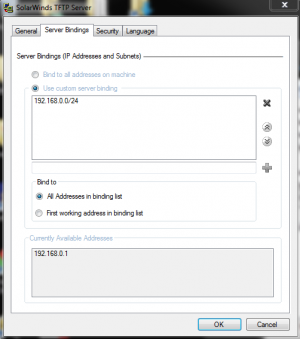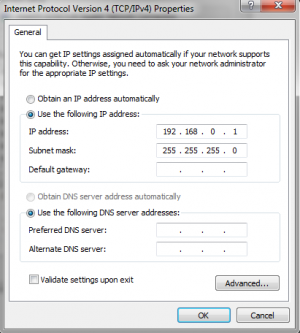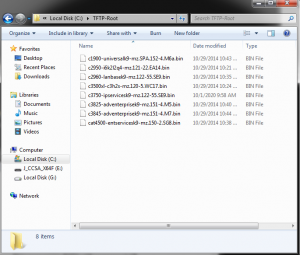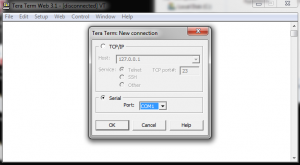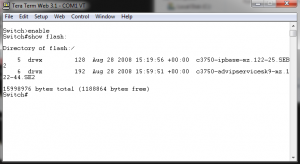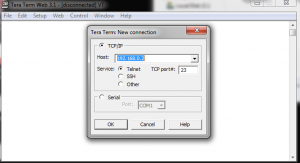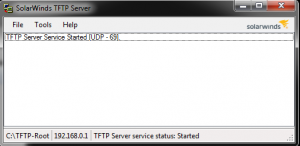Difference between revisions of "Updating IOS On Cisco Switch or Router"
Jump to navigation
Jump to search
(Created page with "Updating an IOS on a Cisco Switch/Router using TFTP Install PuTTy or a similar Telnet application to be able to access the Switch/Router (S/R) through an ethernet connection....") |
(Everything) |
||
| Line 1: | Line 1: | ||
Exact command entries written in <code>{This format}</code> | |||
Updating an IOS on a Cisco Switch/Router Using HyperTerminal | == '''Updating an IOS on a Cisco Switch/Router using TFTP''' == | ||
# Install [https://www.chiark.greenend.org.uk/~sgtatham/putty/latest.html PuTTy] or a similar Telnet application to be able to access the Switch/Router (S/R) through an ethernet connection. | |||
# Install [https://www.solarwinds.com/free-tools/free-tftp-server SolarWinds TFTP server] or similar TFTP application to be able to send the IOS image to the S/R. | |||
# Configure TFTP with the correct IP address (192.168.0.0/24) and change your computer’s ethernet interface adapter the right address range. (Verify the adapter appears in TFTP)[[File:Step 3a.png|center|thumb|IP configuration for the TFTP server.]][[File:Step 3b.png|center|thumb|IP configuration for the PC interface.]] | |||
# Ensure that the correct IOS images are installed on your computer in the designated TFTP folder. (IOS images will have different names from the one pictured below.)[[File:Step 4.png|center|thumb|Verification of IOS Images (May be ''DIFFERENT'' depending on when you are updating.)]] | |||
# Use a computer with a serial cable or similar console connection (COM1) in order to connect to the console port on the S/R.[[File:Step 5.png|center|thumb|COM1 Connection using Tera Term (Serial).]] | |||
# Enter privileged executive mode and verify the ''Flash:'' filesystem has enough space for the new image. [[File:Step 6.png|center|thumb|Verify ''Flash:'' directory size and current IOS while In privileged executive.]] | |||
# Configure the S/R as follows: | |||
#* Enter configuration terminal mode. | |||
#* Configure the console and vty lines (0 4) for remote access to the S/R. (Use password ''Cisco'' to make things easy.)[[File:Step 7a-b.png|center|thumb|Line console and vty 0 4 configurations.]] | |||
#* Configure the appropriate IP on the VLAN1/Interface (192.168.0.0/24 Network). | |||
#* Exit back to privileged executive mode.[[File:Step 7c-d.png|center|thumb|IP address configuration on a switch (Will be an ''INTERFACE'' on a router).]] | |||
#* Clear the ''Flash:'' filesystem (This takes several minutes and it might seem frozen at first, it is working, I promise.) | |||
#* [[File:Step 7e.png|center|thumb|Erasure of ''Flash:'' filesystem.]] | |||
# Use a telnet connection over ethernet on your computer to connect to the address configured on the S/R.[[File:Step 8.png|center|thumb|IP connection to the S/R using Tera Term (Telnet).]] | |||
# Start the TFTP server.[[File:Step 9.png|center|thumb|A running TFTP server.]] | |||
# Enter commands to send a TFTP file over the connection. (Using the computer address as the source. The filename of the IOS must also be EXACT.) | |||
# After the install has finished verify the file is now on the S/R. | |||
# Reload the S/R and do not save the configuration. | |||
# Wait for the reboot and verify that the S/R is a blank configuration with the correct IOS installed in ''Flash:''. | |||
== '''Updating an IOS on a Cisco Switch/Router Using HyperTerminal''' == | |||
ROMMON COMMANDS ARE DIFFERENT FROM REGULAR CLI FOR S/R. CHECK YOUR SYNTAX. | ROMMON COMMANDS ARE DIFFERENT FROM REGULAR CLI FOR S/R. CHECK YOUR SYNTAX. | ||
So you’re the idiot that reloaded an S/R without an IOS on the flash and it only boots into ROMMON? (i.e. switch: ) | |||
Install HyperTerminal using a Windows XP disc. (Find instructions on how here.) | # So you’re the [https://www.merriam-webster.com/dictionary/idiot idiot] that reloaded an S/R without an IOS on the flash and it only boots into ROMMON? (i.e. switch: ) | ||
Connect to the S/R using a console connection over COM1 (Run the .exe file to access HyperTerminal (HT). It may ask for a phone number, you do not need one.) (BAUD rate may also be an issue. The usual default is 9600 bits/sec. If the connection is not working try matching the default BAUD rate of the S/R.) | # Install HyperTerminal using a Windows XP disc. (Find instructions on how [https://www.instructables.com/Port-Hyperterminal-to-Windows-7/ here].) | ||
Check the Flash: filesystem to verify it can fit the new IOS. | # Connect to the S/R using a console connection over COM1 (Run the .exe file to access HyperTerminal (HT). It may ask for a phone number, you do not need one.) (BAUD rate may also be an issue. The usual default is 9600 bits/sec. If the connection is not working try matching the default BAUD rate of the S/R and then use [https://www.cisco.com/c/en/us/support/docs/routers/10000-series-routers/50421-config-register-use.html CONFREG] command to change the rate (Higher rates may run into problems).) | ||
Use copy xmodem command to copy the IOS from the computer. | # Check the ''Flash:'' filesystem to verify it can fit the new IOS. | ||
Click the transfer button and then send file while the previous command is still running to send the file (Use xmodem or xmodem-1K) | # Use copy xmodem: flash:FILENAME command to copy the IOS from the computer. | ||
Once the install has finished verify the IOS has been installed to the Flash: filesystem. | # Click the transfer button and then send file while the previous command is still running to send the file (Use xmodem or xmodem-1K) | ||
Reset the switch and then verify the correct IOS is installed once more. | # Once the install has finished verify the IOS has been installed to the ''Flash:'' filesystem. | ||
# Reset the switch and then verify the correct IOS is installed once more. | |||
Revision as of 16:16, 23 February 2021
Exact command entries written in {This format}
Updating an IOS on a Cisco Switch/Router using TFTP
- Install PuTTy or a similar Telnet application to be able to access the Switch/Router (S/R) through an ethernet connection.
- Install SolarWinds TFTP server or similar TFTP application to be able to send the IOS image to the S/R.
- Configure TFTP with the correct IP address (192.168.0.0/24) and change your computer’s ethernet interface adapter the right address range. (Verify the adapter appears in TFTP)
- Ensure that the correct IOS images are installed on your computer in the designated TFTP folder. (IOS images will have different names from the one pictured below.)
- Use a computer with a serial cable or similar console connection (COM1) in order to connect to the console port on the S/R.
- Enter privileged executive mode and verify the Flash: filesystem has enough space for the new image.
- Configure the S/R as follows:
- Enter configuration terminal mode.
- Configure the console and vty lines (0 4) for remote access to the S/R. (Use password Cisco to make things easy.)
- Configure the appropriate IP on the VLAN1/Interface (192.168.0.0/24 Network).
- Exit back to privileged executive mode.
- Clear the Flash: filesystem (This takes several minutes and it might seem frozen at first, it is working, I promise.)
- Use a telnet connection over ethernet on your computer to connect to the address configured on the S/R.
- Start the TFTP server.
- Enter commands to send a TFTP file over the connection. (Using the computer address as the source. The filename of the IOS must also be EXACT.)
- After the install has finished verify the file is now on the S/R.
- Reload the S/R and do not save the configuration.
- Wait for the reboot and verify that the S/R is a blank configuration with the correct IOS installed in Flash:.
Updating an IOS on a Cisco Switch/Router Using HyperTerminal
ROMMON COMMANDS ARE DIFFERENT FROM REGULAR CLI FOR S/R. CHECK YOUR SYNTAX.
- So you’re the idiot that reloaded an S/R without an IOS on the flash and it only boots into ROMMON? (i.e. switch: )
- Install HyperTerminal using a Windows XP disc. (Find instructions on how here.)
- Connect to the S/R using a console connection over COM1 (Run the .exe file to access HyperTerminal (HT). It may ask for a phone number, you do not need one.) (BAUD rate may also be an issue. The usual default is 9600 bits/sec. If the connection is not working try matching the default BAUD rate of the S/R and then use CONFREG command to change the rate (Higher rates may run into problems).)
- Check the Flash: filesystem to verify it can fit the new IOS.
- Use copy xmodem: flash:FILENAME command to copy the IOS from the computer.
- Click the transfer button and then send file while the previous command is still running to send the file (Use xmodem or xmodem-1K)
- Once the install has finished verify the IOS has been installed to the Flash: filesystem.
- Reset the switch and then verify the correct IOS is installed once more.
